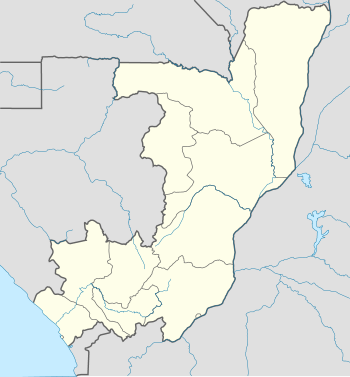List of World Heritage Sites in Congo

The United Nations Educational, Scientific and Cultural Organization (UNESCO) World Heritage Sites are places of importance to cultural or natural heritage as described in the UNESCO World Heritage Convention, established in 1972.[1] Republic of the Congo accepted the convention, making its historical sites eligible for inclusion on the list. As of 2023, Republic of the Congo has two World Heritage Sites, one of them Sangha Trinational it's shared with the neighbouring countries of Cameroon and CAR.[2]
Location of sites[edit]
List of sites[edit]
* Transnational site
| Name | Image | Location | Criteria | Year | Description |
|---|---|---|---|---|---|
| Sangha Trinational | 
|
Sangha Department, Likouala Department | Natural (ix) (x) | 2012 | Situated in the north-western Congo Basin, where Cameroon, Central African Republic and Congo meet, the site encompasses three contiguous national parks totalling around 750,000 ha. Much of the site is unaffected by human activity and features a wide range of humid tropical forest ecosystems with rich flora and fauna, including Nile crocodiles and goliath tigerfish, a large predator. Forest clearings support herbaceous species and Sangha is home to considerable populations of forest elephants, critically endangered western lowland gorilla, and endangered chimpanzee. The site’s environment has preserved the continuation of ecological and evolutionary processes on a huge scale and great biodiversity, including many endangered animal species.[3] |
| Forest Massif of Odzala-Kokoua | 
|
Cuvette-Ouest Department | Natural (ix) (x) | 2023 | This property is an excellent example, at an exceptionally large-scale, of the process of post-glacial forest recolonization of savanna ecosystems. It is therefore ecologically significant as a convergence point of multiple ecosystem types (Congolese Forest, Lower Guinean Forest and Savanna). The broad range of age classifications across the forest succession spectrum contributes to the park’s highly distinct ecology, incorporating a broad range of remarkable ecological processes. It is one of the most important strongholds for forest elephants in Central Africa, and is recognized as the park with the richest primate diversity in the region.[4] |
Tentative List[edit]
| Site | Image | Location | Criteria | Area ha (acre) |
Year of submission | Description |
|---|---|---|---|---|---|---|
| Loango ancient slavery harbour | 
|
Kouilou Department 4°39′22″S 11°48′41″E / 4.656111°S 11.811389°E | Cultural (vi) | 2008 | [5] | |
| Mbé Royal Domain | Pool Department 3°18′14″S 15°53′51″E / 3.3038°S 15.8975°E | Cultural (v) (vi) | 2008 | [6] | ||
| Conkouati-Douli National Park | 
|
Kouilou Department 3°54′18″S 11°28′12″E / 3.905°S 11.47°E | Natural (ix) (x) | 2008 | [7] |
References[edit]
- ^ "The World Heritage Convention". UNESCO. Retrieved December 11, 2023.
- ^ "Congo". UNESCO. Retrieved November 20, 2023.
- ^ "Sangha Trinational". UNESCO World Heritage Centre. Retrieved 2023-11-20.
 Text was copied from this source, which is available under a Creative Commons Attribution 3.0 IGO (CC BY 3.0 IGO) license.
Text was copied from this source, which is available under a Creative Commons Attribution 3.0 IGO (CC BY 3.0 IGO) license.
- ^ "Forest Massif of Odzala-Kokoua". UNESCO World Heritage Centre. Retrieved 2023-11-20.
 Text was copied from this source, which is available under a Creative Commons Attribution 3.0 IGO (CC BY 3.0 IGO) license.
Text was copied from this source, which is available under a Creative Commons Attribution 3.0 IGO (CC BY 3.0 IGO) license.
- ^ "Loango ancient slavery harbour". UNESCO World Heritage Centre (in French). Retrieved 2023-11-20.
- ^ "Mbé Royal Domain". UNESCO World Heritage Centre (in French). Retrieved 2023-11-20.
- ^ "Conkouati-Douli National Park". UNESCO World Heritage Centre (in French). Retrieved 2023-11-20.




